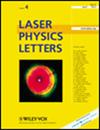Machine-learning-based mapping of blood oxygen saturation from dual-wavelength optoacoustic measurements
IF 1.4
4区 物理与天体物理
Q3 OPTICS
引用次数: 0
Abstract
We developed a novel machine-learning-based algorithm based on a gradient boosting regressor for three-dimensional pixel-by-pixel mapping of blood oxygen saturation based on dual-wavelength optoacoustic data. Algorithm training was performed on基于机器学习的双波长光声测量血氧饱和度绘图
我们开发了一种基于梯度提升回归器的新型机器学习算法,可根据双波长光声数据逐像素绘制三维血氧饱和度图。该算法的训练是根据蒙特卡罗生成的类组织血管介质吸收光能量分布(探测波长为 532 和 1064 nm)以及光声成像装置的经验仪器功能生成的硅学数据进行的,并对独立的硅学数据进行了进一步验证。兔耳血管的活体光声数据被用作测试数据集。所开发的算法可绘制活体血氧饱和度图,并显示由于动静脉功能性吻合,静脉在 15 ℃ 和 43 ℃ 时的血氧饱和度值存在明显差异。这些结果表明,双波长光声成像可作为复杂的多波长定量光声成像的一种经济有效的替代方法。
本文章由计算机程序翻译,如有差异,请以英文原文为准。
求助全文
约1分钟内获得全文
求助全文
来源期刊

Laser Physics Letters
物理-仪器仪表
CiteScore
3.30
自引率
11.80%
发文量
174
审稿时长
2.4 months
期刊介绍:
Laser Physics Letters encompasses all aspects of laser physics sciences including, inter alia, spectroscopy, quantum electronics, quantum optics, quantum electrodynamics, nonlinear optics, atom optics, quantum computation, quantum information processing and storage, fiber optics and their applications in chemistry, biology, engineering and medicine.
The full list of subject areas covered is as follows:
-physics of lasers-
fibre optics and fibre lasers-
quantum optics and quantum information science-
ultrafast optics and strong-field physics-
nonlinear optics-
physics of cold trapped atoms-
laser methods in chemistry, biology, medicine and ecology-
laser spectroscopy-
novel laser materials and lasers-
optics of nanomaterials-
interaction of laser radiation with matter-
laser interaction with solids-
photonics
 求助内容:
求助内容: 应助结果提醒方式:
应助结果提醒方式:


